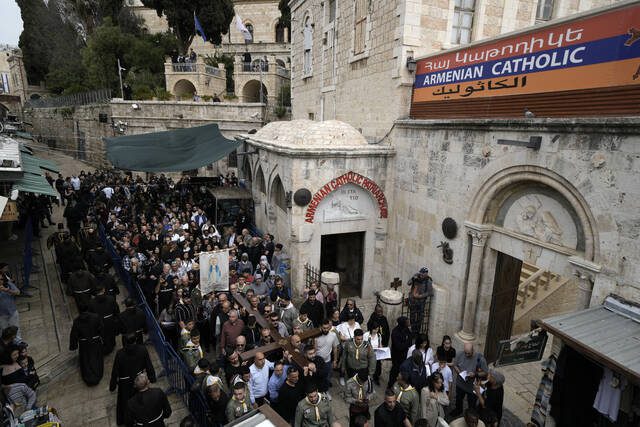JERUSALEM — Many Christians took part in a usual Good Friday march through the stone walls of Jerusalem’s Old City, marking one of the religion’s most important days with smaller crowds due to the ongoing Israel-Hamas conflict.
The march, which typically attracts many foreign visitors, had more local participants this time — mostly Palestinian Christians, along with some expatriates living in Jerusalem and a small number of determined tourists.
The march follows the Way of the Cross, or Via Dolorosa, the path believed to have been walked by Jesus to his crucifixion. Groups of Israeli police set up blockades along the route, redirecting shoppers in the Old City’s busy Muslim quarter to make space for hundreds of pilgrims.
A young group of Palestinian Arab scouts led the day’s march, passing the 14 stations, each marking an event that happened to Jesus on his final journey. Hundreds of Palestinian Christians followed them. Behind them was a small group from the Franciscan religious order, mostly made up of foreigners living in Jerusalem.
“We look forward to this every year,” said Munira Kamar, a Palestinian Christian from the Old City, who waved to the cross-bearers who stopped to give her young daughter a kiss on the cheek. “This year, of course, we are upset because of the situation with the ongoing war.”
Many Palestinians have died in Israel’s continued attack in Gaza, which started after Hamas’ Oct. 7 killings and hostage-taking in Israel.
The impact of the war was evident at the final stations of the march inside the Church of the Holy Sepulcher, where Jesus is believed to have been crucified and laid to rest before his resurrection on Easter. There, instead of the usual crowds waiting for hours in the church courtyard, entry to the site was easy.
There were noticeably fewer Palestinian Christians from the West Bank in the city's streets, as they usually come to the Holy City for Easter. Since Oct. 7, Palestinian worshippers have required special permission to cross checkpoints into Jerusalem.
Despite the smaller crowds, shop owners, whose heavy metal doors are usually closed on Fridays, opened them for tourists wanting Catholic souvenirs. However, there were few shoppers.
“Comparing last year’s Easter celebrations with this year is like night and day,” said Fayaz Dakkak, a Palestinian store owner whose family first opened the shop in 1942. His shop was empty.
“Normally people are happy today and kids are excited,” he said. “But when you compare children here who have water and food and a family to what’s happening in Gaza, how can you be happy?”
An estimated 50,000 Christian Palestinians live in the West Bank and Jerusalem, according to the U.S. State Department’s international religious freedom report for 2022. Approximately 1,300 Christians lived in Gaza, it said. Some Christians are also citizens of Israel. Many Palestinian Christians live in diaspora communities.
A few tourists ventured out for the day. Carmen Ros, a lawyer who resides in Jerusalem, had managed to gather a group of pilgrims from Spain to visit the country for a religious tour. The group rested in the shade outside the church.
"They were scared at first," she said, "but I assured them that here in Jerusalem, it’s safe and there's no violence. We're close to Gaza, but the Christian people are not the target of terrorism."
The festivities happened on the third Friday of the Muslim holy month of Ramadan, with worshippers once again gathering at the revered Al-Aqsa mosque for prayer. Despite fears that the ongoing war would cause clashes at the mosque, Ramadan has been peaceful so far, under tight Israeli security.
Sister Harriet Kabaije, a pilgrim from Uganda who recently moved to Jerusalem to live in a monastery, mentioned that she was praying for the people of Gaza and believed that peace could be achieved in the region.
“Many people think that the war here is natural,” she said. “But when Jesus was in Bethlehem, it was peaceful. We know that people are suffering in Gaza so we carry them in our prayers and pray that peace can return to this land.”
Good Friday around the world
Elsewhere, Pope Francis decided not to participate in the traditional Good Friday procession at the Colosseum in Rome, the Vatican said, in order to “preserve his health ahead of the vigil tomorrow and the Easter Sunday Mass.”
This was the second time Francis had missed the traditional procession during his 11-year papacy, an event that St. John Paul II famously skipped just before he died in 2005. Francis had also missed the event in 2023 due to recovering from bronchitis and the cold weather.
In Spain, several Good Friday street processions were canceled due to storms that brought some much-needed rain to areas facing a prolonged drought. Seville’s brotherhoods had to call off the processions of their large floats carrying sculptures of Jesus and the Virgin for the first time in over a decade due to bad weather.
In Chicago, hundreds of spectators gathered in the city’s Pilsen neighborhood to witness a Good Friday tradition — the 47th Via Crucis procession reenacting scenes from Jesus’ final days.
“It’s the story that we all know from when we were little kids,” said Jason Rodriguez, a Pilsen resident and event volunteer. “This reenactment emphasizes the suffering, strength, and passion that our Lord experienced.”



